SPSS Results: Descriptive and Inferential Statistics
Added on 2023-01-09
21 Pages5359 Words47 Views
SPSS
1
1
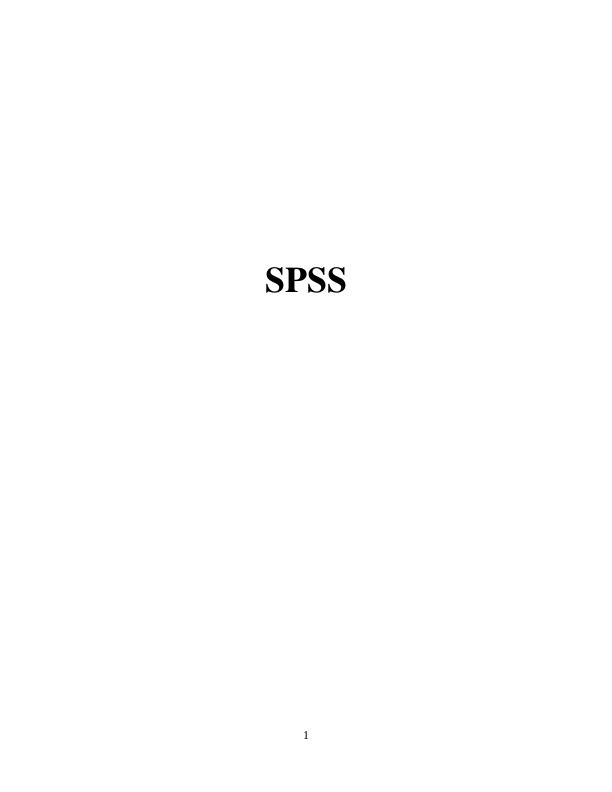
Contents
RESULTS........................................................................................................................................3
Descriptive statistics....................................................................................................................3
Inferential statistics......................................................................................................................4
DISCUSSION..................................................................................................................................6
REFERENCES..............................................................................................................................11
APPENDIX....................................................................................................................................13
1. Descriptive statistics of all the variables...............................................................................13
2. Identification of relationship between IGDTotal and BSI scores using correlation..............17
3. Identification of relationship between IGDTotal and SFmental health using correlation.....17
4. Identification of relationship between IGD and SFgeneral health using correlation............17
5. BSI (dependent variable) x IGDTotal, age, and gender (Independent variable) using
regression...................................................................................................................................18
6. SFmental health (dependent variable) x IGDTotal, age, and gender (Independent variable)
using regression.........................................................................................................................18
7. SFgeneral health (dependent variable) x IGDTotal, age, and gender (Independent variable)
using regression.........................................................................................................................19
2
RESULTS........................................................................................................................................3
Descriptive statistics....................................................................................................................3
Inferential statistics......................................................................................................................4
DISCUSSION..................................................................................................................................6
REFERENCES..............................................................................................................................11
APPENDIX....................................................................................................................................13
1. Descriptive statistics of all the variables...............................................................................13
2. Identification of relationship between IGDTotal and BSI scores using correlation..............17
3. Identification of relationship between IGDTotal and SFmental health using correlation.....17
4. Identification of relationship between IGD and SFgeneral health using correlation............17
5. BSI (dependent variable) x IGDTotal, age, and gender (Independent variable) using
regression...................................................................................................................................18
6. SFmental health (dependent variable) x IGDTotal, age, and gender (Independent variable)
using regression.........................................................................................................................18
7. SFgeneral health (dependent variable) x IGDTotal, age, and gender (Independent variable)
using regression.........................................................................................................................19
2
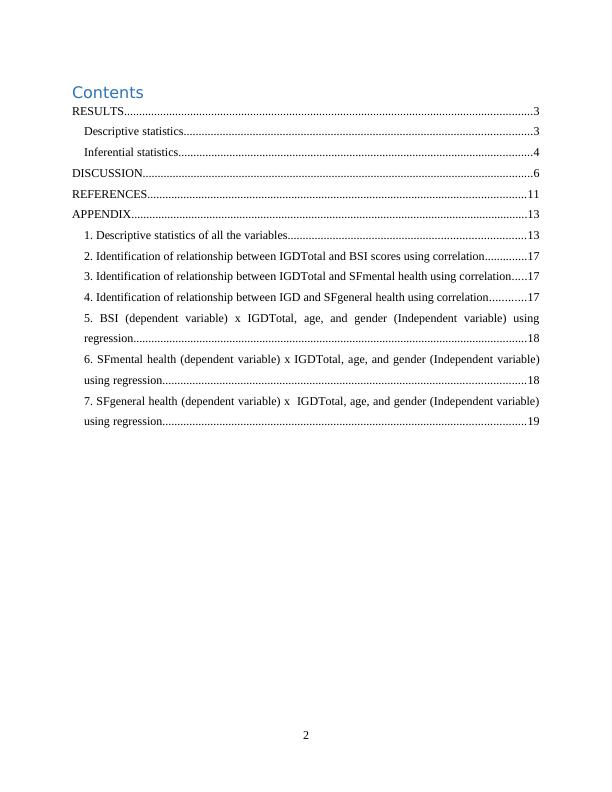
RESULTS
Descriptive statistics
The statistical data which has been collected from 87 participants is divided into certain
categories, these categories include demographic information, Internet Gaming Disorder
information, Brief Symptom Inventory information, mental health information and general health
information. Each of these categories have multiple variables which are required to be analysed
using descriptive statistics. In order to better conclude descriptive, a variable representing each
category is selected for descriptive statistics. IGD total for Internet Gaming Disorder, BSI total
for Brief Symptom Inventory information, SFmental health, SFgeneral health, Gender and age
representing demographic information and lastly fplay representing number of hours per week
spend playing videos games. The results of descriptive statistics and relevant graphical charts are
attached in appendix.
The first variable assessed using descriptive statistics using SPSS is age. The age range
selected for the sample was 18 to 63 years. Out of 87 respondents, 5 has not responded to
3
Descriptive statistics
The statistical data which has been collected from 87 participants is divided into certain
categories, these categories include demographic information, Internet Gaming Disorder
information, Brief Symptom Inventory information, mental health information and general health
information. Each of these categories have multiple variables which are required to be analysed
using descriptive statistics. In order to better conclude descriptive, a variable representing each
category is selected for descriptive statistics. IGD total for Internet Gaming Disorder, BSI total
for Brief Symptom Inventory information, SFmental health, SFgeneral health, Gender and age
representing demographic information and lastly fplay representing number of hours per week
spend playing videos games. The results of descriptive statistics and relevant graphical charts are
attached in appendix.
The first variable assessed using descriptive statistics using SPSS is age. The age range
selected for the sample was 18 to 63 years. Out of 87 respondents, 5 has not responded to
3
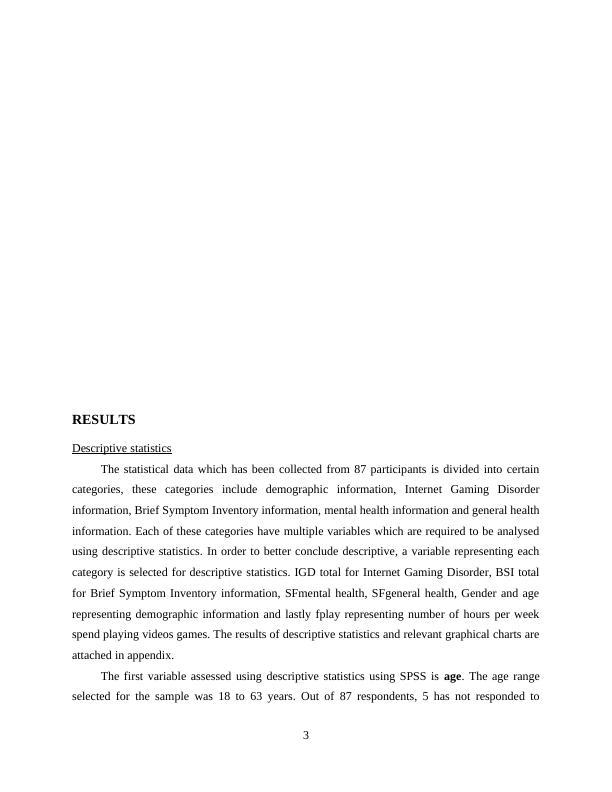
mention their age due to which age is analysed using 82 frequencies. The mean of this data set is
observed to be 24.39 which implies average age of respondents is 24 years and it can be also
implied that video games are most famous among people aged 24. The mode of the age variable
is 21 implying maximum number of respondents have their age as 24 and with the help of its
graphical representation, an exact value of 15 has been seen suggesting 15 people among 82 has
their age as 21. The minimum and maximum values of this variable is 18 and 63 representing
range of sample. Another variable representing demographical information of respondents is
gender. By looking at the descriptive statics table in appendix, it has been observed similar to
age 5 respondents has not responded their gender due to which analysis has been made using 82
data points. Mode of this data set is 1 that indicates maximum number of people who
participated in this study are males which suggests that when compared, males are more inclined
to play video games than females.
IGDtotal is the total score of nine items of IGD questionnaire which aims to analyse the
severity of IGD disorder in participants. These scores will vary from 9 representing least severity
to 45 representing most severity. The descriptive analysis represents mean score of 16.36 which
implies the disorder of gaming is not severe in 82 participants. The maximum value of IGDtotal
is 36 denoting that among 82 gamers, there is an individual who is facing moderate severity on
internet gaming disorder. Another variable analysed is BSItotal representing various conditions
in participants including depression, somatization and anxiety. BSItotal has total scores of 18
variables in which 18 value is representing least severity of BSI and 90 representing high
severity. The descriptive statistics attached in appendix is showing mean value of 26.87 implying
that on an average the participant group is not suffering from depression or anxiety. The
maximum value of such dataset is 61 which implies one among 82 participants is close to having
severe depression and anxiety.
SF mental and general health are two more variable selected for analysis using
descriptive statistics. These variables are the total scores of 38 items divided into 8 scales
including physical functioning, social functioning, mental health and more. The data analysis and
graphical representation is showing mean of SF mental health as 330 and SF general health as
352. According to the scale, higher the scores of participants are, higher their mental and general
4
observed to be 24.39 which implies average age of respondents is 24 years and it can be also
implied that video games are most famous among people aged 24. The mode of the age variable
is 21 implying maximum number of respondents have their age as 24 and with the help of its
graphical representation, an exact value of 15 has been seen suggesting 15 people among 82 has
their age as 21. The minimum and maximum values of this variable is 18 and 63 representing
range of sample. Another variable representing demographical information of respondents is
gender. By looking at the descriptive statics table in appendix, it has been observed similar to
age 5 respondents has not responded their gender due to which analysis has been made using 82
data points. Mode of this data set is 1 that indicates maximum number of people who
participated in this study are males which suggests that when compared, males are more inclined
to play video games than females.
IGDtotal is the total score of nine items of IGD questionnaire which aims to analyse the
severity of IGD disorder in participants. These scores will vary from 9 representing least severity
to 45 representing most severity. The descriptive analysis represents mean score of 16.36 which
implies the disorder of gaming is not severe in 82 participants. The maximum value of IGDtotal
is 36 denoting that among 82 gamers, there is an individual who is facing moderate severity on
internet gaming disorder. Another variable analysed is BSItotal representing various conditions
in participants including depression, somatization and anxiety. BSItotal has total scores of 18
variables in which 18 value is representing least severity of BSI and 90 representing high
severity. The descriptive statistics attached in appendix is showing mean value of 26.87 implying
that on an average the participant group is not suffering from depression or anxiety. The
maximum value of such dataset is 61 which implies one among 82 participants is close to having
severe depression and anxiety.
SF mental and general health are two more variable selected for analysis using
descriptive statistics. These variables are the total scores of 38 items divided into 8 scales
including physical functioning, social functioning, mental health and more. The data analysis and
graphical representation is showing mean of SF mental health as 330 and SF general health as
352. According to the scale, higher the scores of participants are, higher their mental and general
4

health is. The minimum of SF mental health and general health is 100 which indicating low
mental and physical health of people due to playing video games.
Last variable selected for analysis is fplay that represents the number of hours in a week
that a participant spends playing video games. The mean value of such variable is 10.65 which
suggests that on an average a participant spends 10.65 hours in a week solely playing video
games. The maximum value of such variable is 80 hours implying that among 78 participants,
there are people who play video games for 80 hours in a week which is even more than 11 hours
in a day.
Inferential statistics
Correlation is a statistical measure which helps in measuring the relationship between two
variables along with the strength and nature of the relationship. Using SPSS, relationship among
IGDtotal and other variables is computed.
Relationship between IGDTotal and BSI scores (correlation)
The correlation results for such relationship is attached in Appendix. The correlation
table is presenting the Pearson’s correlation coefficient as .406 which representing a significant
but average relationship between IGDtotal and BSItotal. The correlation test is showing
significant position correlation between the participant’s internet gaming disorder and brief
symptom inventory (Depression, Somatization and Anxiety) (p = .000, two tailed). This
relationship implies that with increasing internet gaming disorder, the condition of experiencing
depression and anxiety also increases in a participant (correlation).
Hence, the hypothesis stating that there is a significant relationship between IGD and BSI
is accepted.
Relationship between IGDTotal and SFmental health (correlation)
Using the tool of correlation, IGDTotal is tested along with SFmental health in order to
identify that whether or not there is a relationship in gaming disorder of an individual and their
mental health. The correlation results of the analysis are attached in appendix which represents
the correlation coefficient as -.46. This coefficient shows a significant relationship between
IGDtotal and SFmental health but the strength of this relationship is average and nature of this
relationship is negative as the correlation coefficient has a negative value.
5
mental and physical health of people due to playing video games.
Last variable selected for analysis is fplay that represents the number of hours in a week
that a participant spends playing video games. The mean value of such variable is 10.65 which
suggests that on an average a participant spends 10.65 hours in a week solely playing video
games. The maximum value of such variable is 80 hours implying that among 78 participants,
there are people who play video games for 80 hours in a week which is even more than 11 hours
in a day.
Inferential statistics
Correlation is a statistical measure which helps in measuring the relationship between two
variables along with the strength and nature of the relationship. Using SPSS, relationship among
IGDtotal and other variables is computed.
Relationship between IGDTotal and BSI scores (correlation)
The correlation results for such relationship is attached in Appendix. The correlation
table is presenting the Pearson’s correlation coefficient as .406 which representing a significant
but average relationship between IGDtotal and BSItotal. The correlation test is showing
significant position correlation between the participant’s internet gaming disorder and brief
symptom inventory (Depression, Somatization and Anxiety) (p = .000, two tailed). This
relationship implies that with increasing internet gaming disorder, the condition of experiencing
depression and anxiety also increases in a participant (correlation).
Hence, the hypothesis stating that there is a significant relationship between IGD and BSI
is accepted.
Relationship between IGDTotal and SFmental health (correlation)
Using the tool of correlation, IGDTotal is tested along with SFmental health in order to
identify that whether or not there is a relationship in gaming disorder of an individual and their
mental health. The correlation results of the analysis are attached in appendix which represents
the correlation coefficient as -.46. This coefficient shows a significant relationship between
IGDtotal and SFmental health but the strength of this relationship is average and nature of this
relationship is negative as the correlation coefficient has a negative value.
5
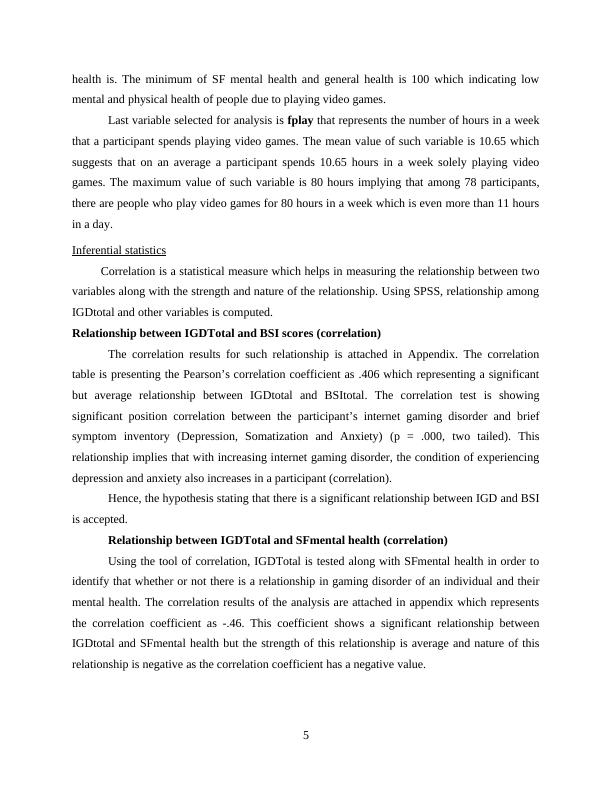
There was a significant negative correlation between the participant’s IGDtotal scores
and SFmental health scores (p = .000, two tailed), indicating that with greater IGD scores of
individuals, the mental health of individual decreases (correlation).
Hence, the hypothesis stating that there is a significant relationship between IGD and
mental health is accepted.
Relationship between IGDTotal and SFgeneral health (correlation)
Another correlation test conducting for present study is between two variables which are
IGDTotal and SFgeneral health. The correlation table is representing the correlation coefficient
as .-335 that indicates there is a significant relationship between both the variables but as the
value is near .3, the strength of this relationship is weak and with a negative value, it can be said
that there is a negative relationship between both the variables.
The results show that there was a statically significant negative correlation between the
participant’s internet gaming disorder and their general health (p = .002, two tailed),
demonstrating that with the increasing score of gaming disorders, individuals starts to have
reducing general health.
The above results accept the hypothesis stating there is a significant relationship between
IGD and mental health scores.
BSI x IGDTotal, age, and gender (regression)
Where correlation can only be used to represent linear relationship between two
variables, regression helps to analyse how various independent variable are statically related to
dependent variable. For the present study, the relationship is analysed between BSI (dependent
variable) and age, gender, IGD (independent variables). The results of regression are attached in
appendix which presents the R square as .31 implying that a difference of 31% in BSI can be
explained by IGD, age and gender. The table of ANOVA represents the significance level and
according to which there BSI is significantly related to GDI, age and gender (p = .000).
Lastly, the table of coefficient shows significant values of each of the independent
variables from which it has been seen that age has a p value of .06 which is more than .05
implying BSI has a significant relationship with IGD and gender but not with age.
SFmental health x IGDTotal, age, and gender (regression)
The second regression test has similar independent variables as the first test but here the
dependent variable is SFmental health. The R square of such relationship is .32 indicating that
6
and SFmental health scores (p = .000, two tailed), indicating that with greater IGD scores of
individuals, the mental health of individual decreases (correlation).
Hence, the hypothesis stating that there is a significant relationship between IGD and
mental health is accepted.
Relationship between IGDTotal and SFgeneral health (correlation)
Another correlation test conducting for present study is between two variables which are
IGDTotal and SFgeneral health. The correlation table is representing the correlation coefficient
as .-335 that indicates there is a significant relationship between both the variables but as the
value is near .3, the strength of this relationship is weak and with a negative value, it can be said
that there is a negative relationship between both the variables.
The results show that there was a statically significant negative correlation between the
participant’s internet gaming disorder and their general health (p = .002, two tailed),
demonstrating that with the increasing score of gaming disorders, individuals starts to have
reducing general health.
The above results accept the hypothesis stating there is a significant relationship between
IGD and mental health scores.
BSI x IGDTotal, age, and gender (regression)
Where correlation can only be used to represent linear relationship between two
variables, regression helps to analyse how various independent variable are statically related to
dependent variable. For the present study, the relationship is analysed between BSI (dependent
variable) and age, gender, IGD (independent variables). The results of regression are attached in
appendix which presents the R square as .31 implying that a difference of 31% in BSI can be
explained by IGD, age and gender. The table of ANOVA represents the significance level and
according to which there BSI is significantly related to GDI, age and gender (p = .000).
Lastly, the table of coefficient shows significant values of each of the independent
variables from which it has been seen that age has a p value of .06 which is more than .05
implying BSI has a significant relationship with IGD and gender but not with age.
SFmental health x IGDTotal, age, and gender (regression)
The second regression test has similar independent variables as the first test but here the
dependent variable is SFmental health. The R square of such relationship is .32 indicating that
6
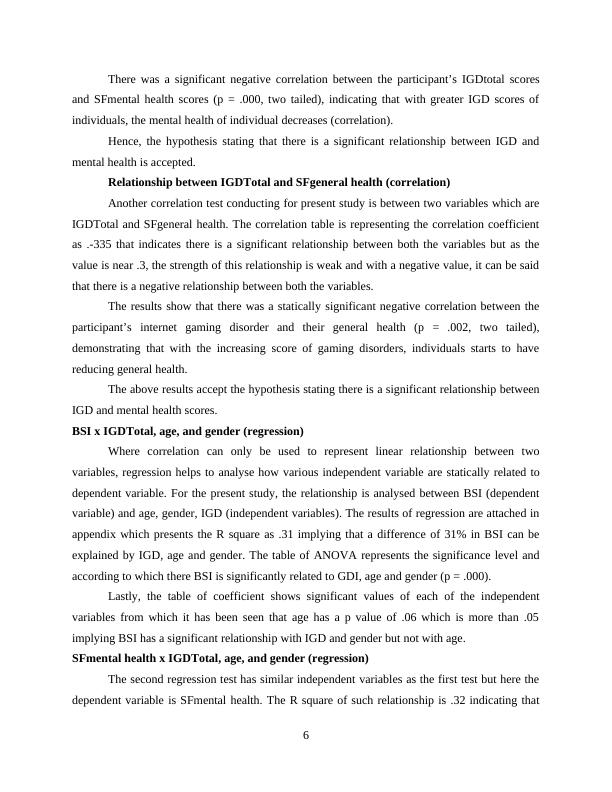
End of preview
Want to access all the pages? Upload your documents or become a member.
Related Documents
Females at Higher Risk of Insomnia: Gender and Insomnia Prevalencelg...
|1
|978
|164
Impact of Social Media on Mental Health: A Literature Reviewlg...
|8
|2634
|380
Introduction to Statistics for Economicslg...
|14
|2421
|64
Data Analysis: Health and Wellbeinglg...
|15
|2740
|358
Quantitative Analysis Reportlg...
|27
|3522
|60
SPSS Analytical Reportlg...
|13
|2171
|122
